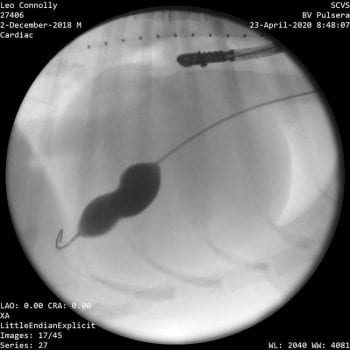1 Jun 2020
Team at Southern Counties Veterinary Specialists treats young Labrador retriever diagnosed with rare congenital heart disease.

Tobi Wagner with Leo.
The veterinary team at Southern Counties Veterinary Specialists (SCVS) has carried out keyhole surgery on a Labrador retriever diagnosed with a rare congenital heart disease.
Owners of Leo, who are from Dublin, were concerned when his abdomen became swollen, and his regular vet suspected heart disease.
He was initially referred to Tom Mulling, a veterinary cardiologist in Dublin, who diagnosed tricuspid valve stenosis – an abnormality of the inflow valve on the right side of the heart (the tricuspid valve) that causes stenosis of the valve and results in congestive heart failure.
In heart failure, and with owners anxious to get cardiac surgery performed before his condition deteriorated, the COVID-19 lockdown both sides of the Irish Sea made it difficult to find a specialist.
However, SCVS – part of the IVC Evidensia Referral Network – reviewed the ultrasound study of Leo’s heart and agreed to take him on as a patient.
After an initial video consultation, Tobi Wagner of SCVS felt Leo was suitable for keyhole intervention, so the family made the trip across the sea by car and ferry with him to Hampshire. The family crowd-funded the cost of the treatment.

Dr Wagner said: “Although this disease cannot be cured, a procedure called balloon valvuloplasty can be performed to alleviate symptoms.
“Balloon valvuloplasty involves placing a balloon across the narrowed valve, which is then inflated to stretch the valve open. This is a ‘keyhole’ procedure, performed via a tiny puncture in the jugular vein.”
Tricuspid stenosis is rare. Balloon valvuloplasty for pulmonic stenosis is a routine procedure, but balloon dilation of the tricuspid valve is not commonly performed.
Dr Wagner continued: “Stephen Collins and I performed the balloon valvuloplasty with one of our specialist anaesthetists, Derek Flaherty, ensuring Leo’s safety during the anaesthetic.
“Leo made a great recovery. Fluid accumulation around the heart, which was related to the heart failure, resolved within 24 hours after the intervention.
“Good reduction of pressure gradients across the narrowed valve were achieved (measured during the op, before and after ‘ballooning’) and the rapid disappearance of fluid congestion following the operation indicated the procedure was a great success.”
Leo made a full recovery and returned to Ireland with his owners the following day.